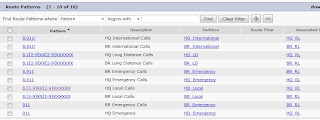It took a lot longer than expected due to life in general; but my voice lab is fully functional. With the current career shift I'll probably be finishing the CIPT1 test and then going back to Routing and Switching. Then after that I'll be moving towards the design certs as my role is now focused on network implementation and design.
I rolled out a few new networks already with my team which includes planning, designing, and implementation. This includes VoIP, wireless, and security so I've been learning a ton. I'm filling all the gaps that's been missing since I was thrown into mainly VoIP from the start.
Anyways I knocked out a lot today:
1. Configured Extension Mobility on my CUCM Servers
2. Created Extension Mobility profiles and logged the users in
3. Re-provisioned HQ PRI to use only 3 channels
4. Configured Partitions and CSS's
5. Configured Route Groups, Lists, and Patterns for both the HQ and Branch site
6. Created Translation Patterns for DID's
7. Configured correct Dial-Peers on PSTN router and Branch Router (HQ Router uses MGCP)
8. Created Corporate GPO on Domain Controller (wanted to relax the default security settings)
Here's a picture of the route patterns I created:
Here's a picture of me testing out a call using a DID:


